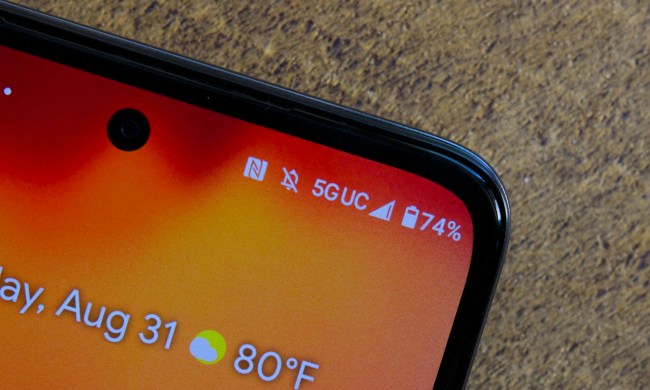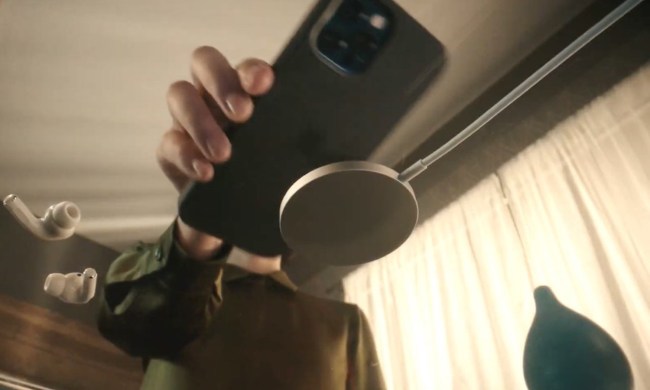“Even though the iPhone 6 is significantly bigger than every previous iPhone, it’s still a manageable size. If you’ve always used an iPhone and aren’t sure you want a phablet, the iPhone 6 might be the way to go.”
- Crisp, bigger screen
- Premium build quality
- Great camera with cool video features
- Small battery
- Not waterproof
- No microSD card
After years of eschewing larger screen sizes, Apple has finally submitted to peer pressure and released two significantly larger iPhones. The iPhone 6 may be the more petite of the two, but it’s still significantly bigger than the 4-inch iPhone 5S. How will iPhone users who’ve never even touched a phablet in their lives react to the iPhone 6 and how does it compare to the competition?
Here’s what we think based on our first impressions of the iPhone 6 and the iPhone 6 Plus. Please note that this is merely a first impressions piece, as we’ve only just gotten our hands on the new iPhone. We will update this post with a more in-depth review as soon as possible.
Hands on video
Incredibly slim and finally bigger
The first thing you notice about the iPhone 6 is the obvious thing — it’s bigger. It seems as though Apple took great care to make the new iPhone feel normal, and it does fit perfectly in any size hands. Part of its success is owed to the slimmer, and slightly rounded design.
The iPhone 5S feels much more square in the hand than the iPhone 6. The iPhone 6’s curves ensure that it nestles into your palms and eases the grip of your fingers on the side. Even so, we found it more slippery to hold, though not as much as the HTC One M8. The screen curves slightly in to meet the body of the phone, furthering the illusion of a perfect, seamless case.
The iPhone 6’s curves ensure that it nestles into your palms and eases the grip of your fingers on the side.
In terms of size, the iPhone 6 is narrower than the 2014 Moto X, but it looks just about as tall as the new Moto, which has a 5.2-inch screen. Oddly, its huge top and bottom bezels make it the same size as the Moto X, even though it has a smaller screen. At this point, it’s a waste of space, but Apple is wedded to the Home button, where its Touch ID fingerprint sensor is located. The iPhone 6 is just a hair narrower than the HTC One M8 and quite a bit shorter.
The power button has now moved to the right-hand side and we found that it aligned with our index finger or thumb well. We’ve been hoping that Apple would move the power button ever since the iPhone 5 came out. The new position makes it much easier to turn the phone on and off. Muscle memory will have hard-core iPhone users looking for the button at the top, but the side switch is easier to reach.
The camera sticks out slightly from the back of the device, but it’s not too noticeable. It’s positioned much closer to the edge of the phone, though, so you’ll have to be careful not to cover the lens when taking pictures as you hold the phone horizontally.
Our review unit features the gold finish, which adds a bit of personality to the design. The only real complaint that we have about the phone’s design is the odd, white lines on the back. Personally, we wish the space between the white lines were filled in white as it is on the iPhone 5S. The lines look sloppy and almost accidental.
iOS 8 shines, but apps need to update
We’ve been using iOS 8 since it arrived on September 17. It looks and works almost exactly like iOS 7, but with a few minor alterations. Unfortunately, two of the biggest features — Apple Pay and HealthKit — are currently unavailable. The HealthKit app isn’t intuitive, easy to use, or particularly useful. The absence of compatible apps due to a bug in the system has only exacerbated the issue.
One of our favorite new features is the ability to add third-party keyboard apps. We tested SwiftKey on our iPhone 5 earlier this week and now we set it up on the iPhone 6. Since the screen is so much bigger, it’s much easier to use the swipe-to-type function, and our fingers have more room to maneuver. We found that we made even fewer typos on the 6.
Certain aspects of iOS 8 are available only on the iPhone 6 and 6 Plus, such as Apple Pay (which hasn’t been released yet) and Reachability, the feature that aims to make using bigger screen iPhones easier for old-school iPhone users.
Tap twice on the Home button, and all your apps slide down to meet your thumb. If you touch anywhere above the apps, the notification shade will drop. Even though we found the 4.7-inch screen easy enough to use one-handed, we could see how Reachability would be helpful on the iPhone 6 Plus.
Sadly, the iPhone 6 doesn’t have landscape mode like the iPhone 6 Plus, so when you tilt the phone horizontally in compatible apps, nothing happens. We were pretty bummed out about this.
The other problem we faced with the user interface on the iPhone 6 was that many apps have yet to update to accommodate the new pixel resolution of the screen and iOS 8 itself. Thanks to scaling, you don’t see those annoying black, dead spaces — which is a very good thing on this much larger screen — but the old apps look a little fuzzy. The issue isn’t as bad on the iPhone 6, but pixel snobs will spot it right away. Of course, as developers update their apps, this problem will disappear.
Specs
The iPhone 6 features minor hardware upgrades, but the 4.7-inch screen has the same pixel density of 326 ppi as the 5S. It has a higher contrast ratio, though, making it appear brighter and the colors slightly richer.
There’s a new 64-bit A8 processor onboard alongside 1GB of RAM (we think) and the new M8 motion coprocessor. The iPhone 6 loads websites faster than the iPhone 5 and YouTube videos streamed just a bit faster on the 6, but the difference isn’t astonishing.
Most users will probably fork over the extra $100 for the 64GB version and we think that’s just highway robbery.
The iPhone 6 scored 17,309 on the 3D Mark Ice Storm Unlimited benchmark test, which is much lower than the 2014 Moto X’s score of 19,395 and less than the Samsung Galaxy S5’s 18,500. On the Geekbench 3 test, the iPhone 6 scored 1,622 in the single core test and 2,906 in the multi-core test.
In terms of connectivity, the iPhone 6 has 802.11a/b/g/n/ac Wi‑Fi, Bluetooth 4.0, and finally, NFC, though it’s limited to Apple Pay for now. It’s also got Wi-Fi calling on T-Mobile’s network and VoLTE.
We were very disappointed that Apple didn’t waterproof the iPhone 6, especially now that it’s becoming a standard feature on Android smartphones. However, the most irritating thing about the iPhone 6 is Apple’s failure to increase the minimum storage option from 16GB to 32GB. In this day and age, 16GB is simply not enough for the average user. Most people will probably fork over the extra $100 for the 64GB version — we think that’s just highway robbery. The lack of a MicroSD card slot is also upsetting, though not surprising.
The iPhone 6 also runs hot when you watch videos or download tons of app updates all at once. It didn’t burn our hands, but it sure was hot.
Sharper camera focuses in on details
Even though the iPhone 6 has the same 8-megapixel resolution camera on the back as the iPhone 5, it shoots sharper photographs. In our tests, the iPhone 6 captured much more detail in close-ups and shots from a distance. Colors also appear to be richer, and focusing in on light areas of a photo doesn’t seem to bleach the colors as much.
As we mentioned earlier in this review, the camera module sticks out from the body and is located closer to the edge of the phone. We found ourselves touching the lens from time to time when we took landscape photographs.
The iPhone 6 shoots 1080p video in 30 or 60 fps. Thanks to iOS 8, the iPhone 6 also has a time-lapse video function, which speeds up video and a slo-mo function. We took a time-lapse video with our iPhone 5 earlier today and found it pixelated on our Macbook Air. In comparison, the iPhone 6 delivers crystal clear time-lapse videos.
Calling & Data speed
As expected, the data speed on T-Mobile’s network was very fast. We could even stream YouTube videos without a single hitch or buffering.
Battery
Since we haven’t been able to extensively test the iPhone 6 over days yet, we can’t tell you how the iPhone 6’s battery fares after a full day’s use, but we do know that its 1,810mAh battery is just slightly bigger than the 1,560mAh battery in the 5S. iPhone battery life is notoriously bad; we’ll let you know soon if Apple has improved it on the iPhone 6.
Conclusion
Apple’s iPhone 6 may not be a revolutionary device, and there’s no denying that it’s playing catch up with Android smartphones in many ways, but this phone still easily ranks among the top smartphones of 2014. Overall, the iPhone 6 is a modest upgrade over the iPhone 5S. The screen size and new slim, rounded design are the biggest changes. To Android users, these features are old hat, but to iPhone users, it’s a huge, huge change.
Even though the iPhone 6 is significantly bigger than every previous iPhone, it’s still a manageable size. If you’ve always used an iPhone and aren’t sure you want a phablet, we’d recommend that you go with the iPhone 6. And if you are an Androider, give iOS a look.
Highs:
- Crisp, bigger screen
- Premium build quality
- Great camera with cool video features
Lows:
- Small battery
- Not waterproof
- No microSD card




















